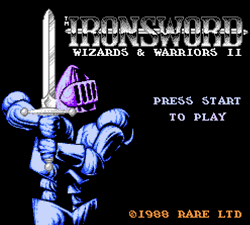 We live in an age of science and reason. We have knowledge of vaccines, microbes, and the periodic table of elements. But it took us a long time to get to this point. For hundreds of years, our understanding of the universe was much more limited, and our thoughts on how the world worked were based on simple, rudimentary building blocks of the universe. Obviously, I am talking about the four elements of nature: fire, wind, water, and earth.
We live in an age of science and reason. We have knowledge of vaccines, microbes, and the periodic table of elements. But it took us a long time to get to this point. For hundreds of years, our understanding of the universe was much more limited, and our thoughts on how the world worked were based on simple, rudimentary building blocks of the universe. Obviously, I am talking about the four elements of nature: fire, wind, water, and earth.
But… why?
It’s interesting to consider how many different cultures and regions settled on the same basic group of elements. The basis of Western thinking in Ancient Greece had ironed out the four elements before Aristotle, but it was that king of philosophers that further outlined important bits of the lore (“science!”), such as “fire is hot and dry while water is cold and wet”. That’s why that dude got so many statues! But this isn’t a matter of everyone on Earth running with some Grecian ideas, Babylonia had gods that were personified as the “cosmic” elements sea, earth, sky, and wind. In India, the theoretical start of both Hinduism and Buddhism referenced a similar elemental quartet that occasionally included a fifth (space/zero/”spirit”) buddy. Buddhism even went as far as creating four elements of abstracts to properly parallel the more concrete elements of nature. It seems like the odd man out of the usual ancient “four elements” is China, which decided to forsake “wind” for “wood”, and also toss “metal” into the mix to create a perfect little pentagram of strengths and weaknesses. Fire melts metal, metal chops wood, wood is super effective against ground types. Of course, even western thinking would adopt metal in time, as it wound up as part of alchemy, which would greatly influence modern scientific thinking, as alchemy essentially pioneered concepts like different states of matter.
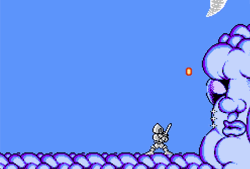 But who cares about the science of the elements? What has really persisted to this day has been the continual existence of “four elements” in pop culture. What was your first introduction to the elements? Was it Final Fantasy’s four crystals? Star Trek: The Next Generation’s S07e16: Thine Own Self? Avatar: The Last Air Bender? Artus Wolffort’s 1641 painting? Whatever was your first, know that this is not going away for future generations. Disney’s Frozen 2 was released sometime back when movie theaters were viable, and it led up to the reveal that there is a magical cave in a magical land that contains four elemental crystals. And Elsa is the missing fifth element (the element of merchandising). The four elements is a trope that is literally older than the written word, and it seems like it is going to be an element of our storytelling for generations to come.
But who cares about the science of the elements? What has really persisted to this day has been the continual existence of “four elements” in pop culture. What was your first introduction to the elements? Was it Final Fantasy’s four crystals? Star Trek: The Next Generation’s S07e16: Thine Own Self? Avatar: The Last Air Bender? Artus Wolffort’s 1641 painting? Whatever was your first, know that this is not going away for future generations. Disney’s Frozen 2 was released sometime back when movie theaters were viable, and it led up to the reveal that there is a magical cave in a magical land that contains four elemental crystals. And Elsa is the missing fifth element (the element of merchandising). The four elements is a trope that is literally older than the written word, and it seems like it is going to be an element of our storytelling for generations to come.
But it’s difficult to determine exactly why the elements are so enduring. Yes, there is simplicity to the elements, but are they as much a part of modern life as they were back in the day? Absolutely not. I can’t remember the last time I had to give a damn about soil. Is that even still around? Or is it about the simplicity of “systems” that arise from the elements? Everybody can understand water beats fire, but that only really explains the presence of elements in videogames. Games are important (he wrote on the videogame blog), but they are not responsible for late 20th century Bruce Willis box office smashes. What’s the modern appeal of the elements? Why are they so persistent across media? Why are we eternally damned to ponder the effectiveness of “wind”?
Ironsword: Wizards & Warriors II has the answer: the four elements are terrifying.
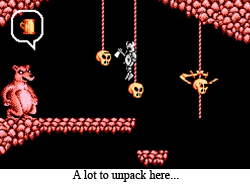 Wizards and Warrios was a pretty… passable NES title, and W&W2 is… well, I can’t in good conscious say Ironsword is at all a good game. It’s not a bad game, but it was also one of my childhood NES titles (I assume my grandmother was distracted by Fabio on the cover, and bought it for me without a second thought), and, like its sequel, it is a very… broken game. There are some great ideas here! Every stage follows a basic three act rhythm (please the local animal king, find the wizard-bane spell, murder the wizard) with two distinct areas, effectively creating a large, ten stage world. That’s pretty great for the era! Also significant for the time is a bevy of bulky, expressive sprites. And Kuros actually graphically upgrades as he tempers his gear, so you go from being some dork with bug eyes and a butter knife to a heavily armored murder machine by the time you are tackling Ice-Fire Mountain.
Wizards and Warrios was a pretty… passable NES title, and W&W2 is… well, I can’t in good conscious say Ironsword is at all a good game. It’s not a bad game, but it was also one of my childhood NES titles (I assume my grandmother was distracted by Fabio on the cover, and bought it for me without a second thought), and, like its sequel, it is a very… broken game. There are some great ideas here! Every stage follows a basic three act rhythm (please the local animal king, find the wizard-bane spell, murder the wizard) with two distinct areas, effectively creating a large, ten stage world. That’s pretty great for the era! Also significant for the time is a bevy of bulky, expressive sprites. And Kuros actually graphically upgrades as he tempers his gear, so you go from being some dork with bug eyes and a butter knife to a heavily armored murder machine by the time you are tackling Ice-Fire Mountain.
But the drawbacks of Ironsword are significant. For one thing, this game has been in existence for 31 years, and our top scientists still haven’t discovered how you’re supposed to attack monsters without suffering damage. There is probably some intended suitable technique for ramming Kuros’s sword into the nearest demon creature, but, unless you’re using magic (available only at the tail end of every level), you’re probably going to take some hits just attempting to clear out the local creatures. And then there’s the platforming that involves an awful lot of inclines that shove Kuros every which way but up. Are you just missing a jump? Or is your hero weirdly magnetizing to surfaces that are trying to kill him? Who knows! And don’t even get me started on the economy of small keys, and how there are far more treasure chests than there are keys, and how you’re apparently going to be stuck grinding gold because you blew your inventory on opening the wrong chest. Random isn’t fun, Ste Pickford, and it never was!
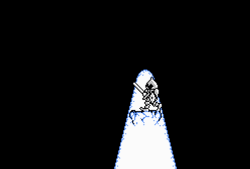 But there is one thing Ironsword gets absolutely right: Malkil is a bastard. Malkil was the ultimate boss and source of Kuros’s misery in the original Wizards and Warriors, but he was blown into non-corporeal bits at the end of that adventure. But you can’t keep a bad wizard down, so Malkil somehow extended his life force to possess the four elements. Now Malkil is an angry cloud in the air, some manner of giant block of ice in a river, sentient lava in a volcano, and a particularly pissed off rock deep in the Earth. These are all huge bosses (particularly by NES standards), and Kuros has to acquire distinct spells just to stand a remote chance against these corrupted elements. And, assuming Kuros can pull that off (possibly with the help of a Game Genie), then the final battle becomes a fight between Kuros and all four of the elements high above a mountaintop. Kuros has obtained the titular Ironsword (fifth element?) at this point, but Malkil is zooming around as four separate elemental ghosts (or… something), so saving the day is locked behind one of the most annoying battles of 1989. If you win, the four animal kings will thank you, but if you lose, you’re in good company, because that final fight is rough.
But there is one thing Ironsword gets absolutely right: Malkil is a bastard. Malkil was the ultimate boss and source of Kuros’s misery in the original Wizards and Warriors, but he was blown into non-corporeal bits at the end of that adventure. But you can’t keep a bad wizard down, so Malkil somehow extended his life force to possess the four elements. Now Malkil is an angry cloud in the air, some manner of giant block of ice in a river, sentient lava in a volcano, and a particularly pissed off rock deep in the Earth. These are all huge bosses (particularly by NES standards), and Kuros has to acquire distinct spells just to stand a remote chance against these corrupted elements. And, assuming Kuros can pull that off (possibly with the help of a Game Genie), then the final battle becomes a fight between Kuros and all four of the elements high above a mountaintop. Kuros has obtained the titular Ironsword (fifth element?) at this point, but Malkil is zooming around as four separate elemental ghosts (or… something), so saving the day is locked behind one of the most annoying battles of 1989. If you win, the four animal kings will thank you, but if you lose, you’re in good company, because that final fight is rough.
And that’s exactly the way the four elements should be.
Aang is allowed to preach balance, and Pokémon is allowed to claim there is always a strength for every weakness. But the sad truth of the matter is that humanity sucks in comparison to all-powerful nature. We build homes. We make cities. We claim to have conquered this wild world, but when the world decides to really get wild, we’re doomed. Let’s review those four elements again, shall we? Water brings floods, and, thanks to the general greed of humanity, much of our land is slated to be submerged beneath the waves. Wind is the domain of hurricanes, and, if you’ve never had a tree fall on your home/car/grandma, congratulations, you’re not currently in a month’s long negotiation with your insurance agency. Earth occasionally quakes, and the slightest rumble is going to really wreck up your gundam collection. And fire, theoretically the most manageable of all natural disasters (it’s not like it can literally zap us from the heavens or something), is occasionally spurned by the revelation of gender, and can thus burn into coasts to cinders. And this is all before when elements decide to work together, building the impressive fire tornado of our worst nightmares. In short, the elements are terrifying, 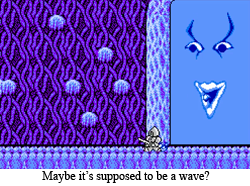 and if you need evidence of this, there are good odds you literally don’t have to do more than peak your head out your window (“Yes, grandma, I can hear you, but I’m writing an article right now, and the lawyers say I’m not supposed to move that branch until after the settlement. I’ll bring some noodles out to you later, okay?”).
and if you need evidence of this, there are good odds you literally don’t have to do more than peak your head out your window (“Yes, grandma, I can hear you, but I’m writing an article right now, and the lawyers say I’m not supposed to move that branch until after the settlement. I’ll bring some noodles out to you later, okay?”).
So thank you, Ironsword, for reminding us why the four elements are still relevant today. It’s not about balance. It’s not about magical crystals in a princess’s magical cave. It’s about fear. It’s about terror. It’s about the fact that if even a single element decided to turn against humanity (with or without the assistance of an evil wizard), it’s going to be a bad time. In the face of a tidal wave or raging fire, we are little more than a jumpy dude wielding a pointy stick. In our world, there is no spell of Earth’s bane, and we are wholly at the mercy of the four elements.
Thanks, Kuros, for reminding us all that we are nothing next to the four elements of the Earth.
FGC #539 Ironsword: Wizards & Warriors II
 System: Nintendo Entertainment System, and then never again. The Rare Replay passed this warrior by.
System: Nintendo Entertainment System, and then never again. The Rare Replay passed this warrior by.- Number of players: Kuros stalks the land alone.
- Best Magic Spell: The Asp’s Tongue spell is apparently a magical spell that allows the heroic Kuros to rob a shopkeeper. Look, whatever it takes to get a dude to toss meat in the air for a solid minute.
- Like writing your name in the sand: This game does not have a battery backup. This means that you are welcome to put your name in the high score table all you want, but it’s never going to last past a power off. However, this is one of the ol’ password-based NES titles, so you can “save” your progress in that aggravating manner. Try to remember which character in the password determines your life count!
- What’s in a name? “Malkil” is a portmanteau of “kill” and “mal”, which is the Latin prefix for “bad”. But Malkil is just his last name, his full name is Angry Murder Malkil.
- Did you know? Kuros can acquire extra points by finding “The Relics of Sindarin” hidden in each level. These relics include a book, ring, gauntlet, and a cross. “Sindarin” is the Elven-Tongue from the Lord of the Rings. So the implication of the Sindarin Cross is obvious: Elves believed in Jesus.
- Would I play again: I hate this game. I will not be accepting questions about that at this time.
What’s next? Random ROB has chosen… Avenging Spirit! That spirit gonna get his revenge! Please look forward to it!
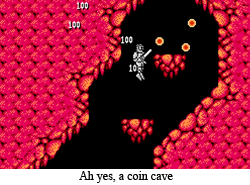
I really like some of the aesthetics of Iron Sword, but in trying to replay the game over a decade and a half ago one thing that really annoyed me was all the platforming. The stages are all big and mazey and very vertically designed and it’s really easy to lose a lot of progress if you slip and fall.